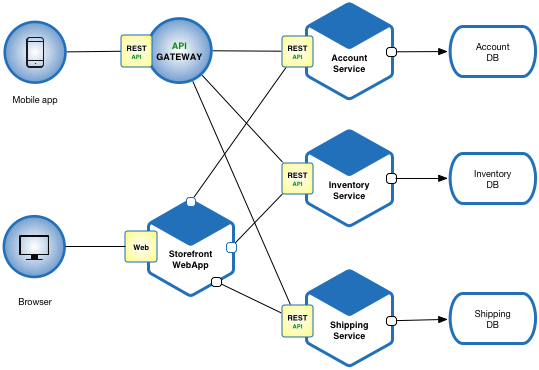| Table of Contents |
|---|
...
Microservices Application Pattern
Please see the example applications developed by Chris Richardson. These examples on Github illustrate various aspects of the microservice architecture.
Resulting Context
Benefits
...
blockchain interoperability on atomic transactions using escrow transactions
context
assume 2 different orgs on 2 different blockchains on 2 different platforms want to execute a sale using an order (any type of asset )
blockchains implement escrow transaction interface services in a smart contract
2 independent chains A and B can send messages using a common protocol ( gRPC or ??? )
party A wants to buy X from party B for Y currency amount
problems
how to ensure only authorized parties participate in the transaction
how to ensure both parties will execute their transaction once and only once to complete the purchase transaction
how to ensure that the purchase is cancelled if either party fails to complete their part of the purchase transaction within the designated time limit
pre-requisites
network connectivity
blockchain directory services and access
identity, registration and access management services for all parties in a transaction
each party implements the escrow transaction interfaces
each party communicates using one of the supported protocols: gRPC or ?
each party digital certificates to sign and execute transactions identifying the authorized party
gateway nodes connect 2 different logical blockchain networks directly or indirectly ( blockchain networks normally not physical but virtual overlay networks across multiple provider networks )
solution
use an escrow transction with smart contracts that
records each parties performance of the obligation
This follows a saga pattern to implement the escrow transaction (eg a purchase ) as a set of linked transactions in smart contracts
Singe Use Tokens are used to guarantee that only this single reservation transaction can be executed once by the designated party
step 0 - party A agrees to buy X from party B for Y currency amount agreeing to a set of policies to execute the transaction for the buyer and the seller roles
step 1 - reservation for payment from A to B with a token, reservation for delivery from B to A with a token
step 2 - when both reservations complete, the reservations are executable as smart contracts by each party
each party executes their reservation transaction via smart contract using the supplied single use token created for just this transaction
A executes B's reservation using the token from B
B executes A's reservation using the token from A
alternate scenarios
both reservations are not completed within the agreed time limit, all reservations and tokens are cancelled and resources revert to current owner control
the purchase policy agreed to may include automated contracts to execute actions to reverse one or both reservation executions or cancel the reservations updating the blockchain
step 3 - if both reservations are not executed as transactions within an agreed time limit, each party is notified to manage the purchase based on agreed policy
step 4 - when both reservations have been executed by each party, all parties are notified of the completion of the escrow transaction
step 5 - any dependent actors are notified of the completion of the purchase which may trigger additional transactions ( eg start an automatic purchase warranty etc )
P2P Escrow Transaction Pattern
goals
- 2 parties complete an atomic swap of asset 1 for asset 2 without risk
- optionally, a 3rd party notary service may need to approve the transaction
- optionally, a 3rd party observer service may record the transaction
- optionally, the 2 parties may be on different networks
context
assume 2 different orgs on 2 different blockchains on 2 different platforms want to execute a sale using an order (any type of asset )
...
party A wants to buy X from party B for Y currency amount
problems
how to ensure only authorized parties participate in the transaction
...
how to ensure that the purchase is cancelled if either party fails to complete their part of the purchase transaction within the designated time limit
pre-requisites
network connectivity
blockchain directory services and access
...
gateway nodes connect 2 different logical blockchain networks directly or indirectly ( blockchain networks normally not physical but virtual overlay networks across multiple provider networks )
solution
use an escrow transction with smart contracts that
...
